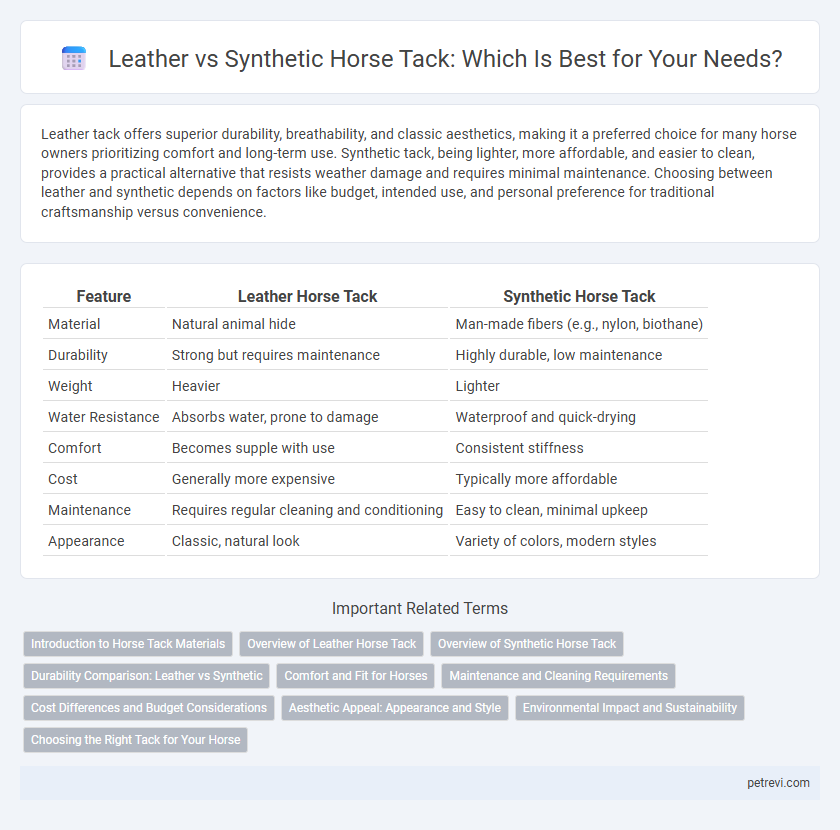Leather tack offers superior durability, breathability, and classic aesthetics, making it a preferred choice for many horse owners prioritizing comfort and long-term use. Synthetic tack, being lighter, more affordable, and easier to clean, provides a practical alternative that resists weather damage and requires minimal maintenance. Choosing between leather and synthetic depends on factors like budget, intended use, and personal preference for traditional craftsmanship versus convenience.
Table of Comparison
| Feature | Leather Horse Tack | Synthetic Horse Tack |
|---|---|---|
| Material | Natural animal hide | Man-made fibers (e.g., nylon, biothane) |
| Durability | Strong but requires maintenance | Highly durable, low maintenance |
| Weight | Heavier | Lighter |
| Water Resistance | Absorbs water, prone to damage | Waterproof and quick-drying |
| Comfort | Becomes supple with use | Consistent stiffness |
| Cost | Generally more expensive | Typically more affordable |
| Maintenance | Requires regular cleaning and conditioning | Easy to clean, minimal upkeep |
| Appearance | Classic, natural look | Variety of colors, modern styles |
Introduction to Horse Tack Materials
Horse tack materials primarily include leather and synthetic options, each offering distinct advantages for durability and maintenance. Leather tack is traditionally favored for its strength, breathability, and classic appearance, aging well with proper care. Synthetic tack, made from materials like nylon or biothane, provides lightweight, weather-resistant qualities and easy cleaning, making it popular for everyday use and humid climates.
Overview of Leather Horse Tack
Leather horse tack provides durability, breathability, and a classic aesthetic highly valued in equestrian disciplines such as dressage and eventing. Genuine leather offers a natural grip and flexibility that improves with use, conforming to the horse's movement for enhanced comfort and control. Maintenance involves regular cleaning and conditioning to preserve the leather's strength and prevent cracking, ensuring long-term performance and safety.
Overview of Synthetic Horse Tack
Synthetic horse tack, made from materials such as biothane, nylon, and synthetic leather, offers lightweight durability and easy maintenance compared to traditional leather tack. These materials are resistant to water, mold, and mildew, making them ideal for wet or humid environments and reducing the need for regular conditioning. Synthetic tack is often more affordable, suitable for riders seeking cost-effective options without sacrificing strength or functionality.
Durability Comparison: Leather vs Synthetic
Leather horse tack is renowned for its durability, often lasting many years with proper care, as natural fibers strengthen over time and resist wear and tear. Synthetic tack, typically made from materials like biothane or nylon, offers high resistance to moisture, mold, and UV damage while requiring less maintenance than leather. Although synthetic tack may not age as gracefully as leather, it provides consistent durability in wet or harsh environments where leather might degrade faster.
Comfort and Fit for Horses
Leather tack offers superior breathability and molds naturally to a horse's body, enhancing comfort and providing a personalized fit that reduces chafing and pressure points. Synthetic tack, while often lighter and easier to clean, may lack the flexibility of leather, potentially causing discomfort or improper fit during extended use. Prioritizing tack material directly affects a horse's performance and wellbeing, with leather typically favored for optimal comfort and anatomical conformity.
Maintenance and Cleaning Requirements
Leather horse tack requires regular cleaning with saddle soap and conditioning to prevent drying and cracking, ensuring longevity and maintaining suppleness. Synthetic tack offers easier maintenance, as it can be washed with mild soap and water without the need for conditioning, making it more resistant to weather and dirt buildup. Choosing between leather and synthetic depends on balancing the time investment for upkeep with durability needs and personal preference for tack aesthetics.
Cost Differences and Budget Considerations
Leather horse tack typically involves higher upfront costs due to the quality and durability of natural materials, often ranging from $150 to $500 per piece. Synthetic tack offers a more budget-friendly alternative, with prices generally between $50 and $200, making it accessible for riders seeking affordability without sacrificing functionality. Maintenance expenses also differ, as leather requires regular conditioning, whereas synthetic materials demand less upkeep, impacting overall long-term budget planning.
Aesthetic Appeal: Appearance and Style
Leather horse tack offers a classic, rich aesthetic with natural grain patterns and a polished finish that enhances traditional equestrian style. Synthetic tack provides vibrant color options and a sleek, uniform appearance that appeals to riders seeking modern and low-maintenance gear. Both materials influence the horse's overall presentation in shows and competitions, with leather being favored for elegance and synthetic for contemporary flair.
Environmental Impact and Sustainability
Leather horse tack is biodegradable and sourced from natural materials, but its environmental impact includes deforestation, water use, and chemical pollution during tanning. Synthetic tack, often made from plastics like nylon or polyurethane, has a lower initial resource demand but contributes to microplastic pollution and landfill waste due to its non-biodegradable nature. Choosing sustainable horse tack involves balancing durability, recyclability, and the ecological footprint of raw materials and production processes.
Choosing the Right Tack for Your Horse
Choosing the right tack for your horse involves comparing leather and synthetic materials based on durability, comfort, and maintenance. Leather tack offers traditional strength, breathability, and a natural feel that enhances horse comfort but requires regular cleaning and conditioning. Synthetic tack provides lightweight, weather-resistant options that are easier to clean and more affordable, making it suitable for beginner riders or wet climates.
Leather vs Synthetic for Horse Tack Infographic

 petrevi.com
petrevi.com